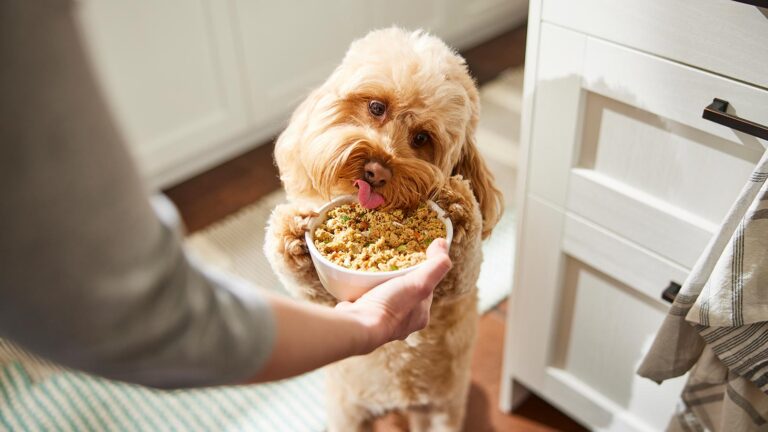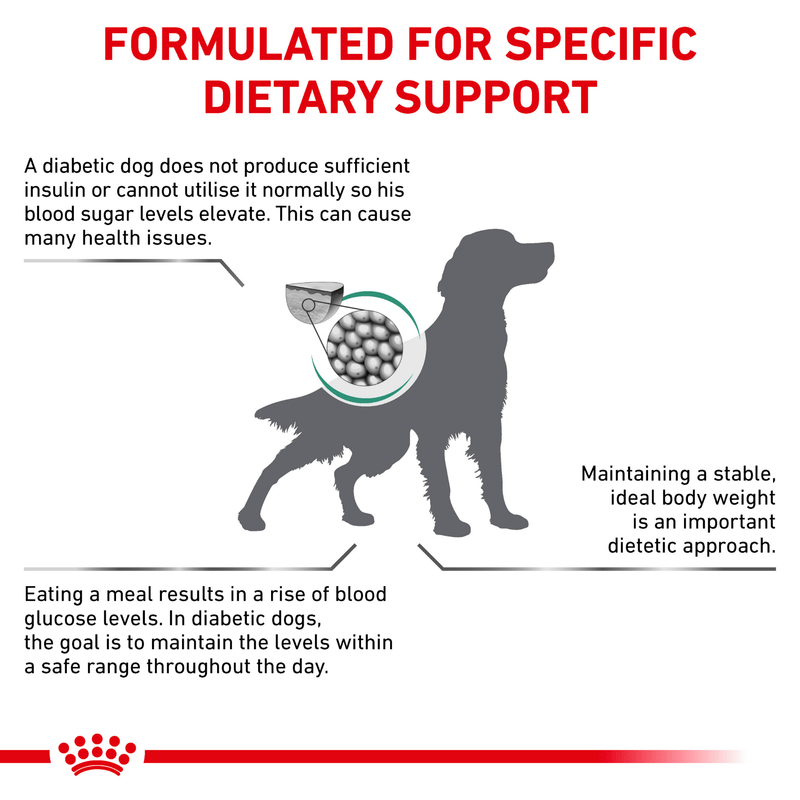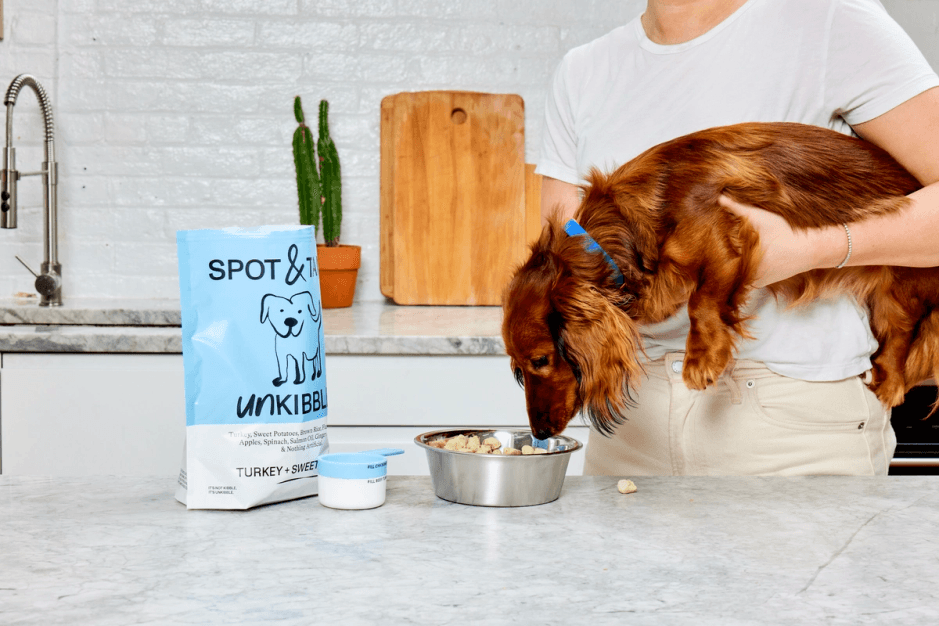If your dog has diabetes, you’re probably feeling worried and unsure about what to feed them. What you put in their bowl can make a huge difference in keeping their blood sugar steady and their energy up.
Feeding your diabetic dog the right foods isn’t just about nutrition—it’s about giving them a better, healthier life. You’ll discover simple, clear advice on the best foods to help manage your dog’s diabetes. Keep reading to learn how to make mealtime safe, tasty, and supportive for your furry friend.
Signs Of Diabetes In Dogs
Diabetes in dogs can be tricky to spot. Knowing the signs helps you act quickly.
Dogs with diabetes often show specific symptoms. These signs can help identify the condition early.
Increased Thirst
Diabetic dogs often drink more water than usual. This is because their bodies try to flush out excess sugar.
- Check water bowls frequently
- Monitor for changes in drinking habits
Frequent Urination
If your dog needs to go out more often, it might be a sign. Dogs with diabetes urinate more due to increased thirst.
- Watch for accidents in the house
- Note if your dog asks to go out more
Weight Loss
Even if your dog eats the same amount, weight loss can occur. This is because their body can’t use nutrients properly.
- Check your dog’s weight regularly
- Look for changes in their body shape
Increased Hunger
Your dog may seem hungrier than before. Their body is trying to get more energy by eating more food.
- Notice if your dog finishes meals faster
- See if they beg for food more often
Lethargy
A diabetic dog might be less active. They can feel tired because their body isn’t getting enough energy.
- Observe if your dog sleeps more
- Check if they show less interest in play

Credit: www.chewy.com
Why Diet Matters For Diabetic Dogs
Diet plays a key role in managing diabetes in dogs. The right food helps control blood sugar levels.
Feeding a diabetic dog properly can improve their quality of life. It supports insulin treatment and overall health.
Consistent Carbohydrate Intake
Carbohydrates affect blood sugar the most. Diabetic dogs need steady, consistent carbs each day.
Choose foods with low glycemic index carbs. These carbs release sugar slowly and keep levels stable.
- Sweet potatoes
- Brown rice
- Barley
- Oatmeal
High Fiber Content
Fiber slows down sugar absorption in the intestines. It helps keep blood sugar from spiking.
Foods rich in fiber support good digestion and reduce insulin needs.
- Vegetables like green beans and carrots
- Whole grains
- Psyllium husk supplements
Adequate Protein Levels
Protein helps maintain muscle mass and energy. It also has little effect on blood sugar.
Choose high-quality protein sources that are easy to digest for your dog.
- Chicken
- Turkey
- Fish
- Eggs
Avoid Sugary And Fatty Foods
Sugary foods cause quick blood sugar spikes. Fatty foods can cause weight gain and insulin resistance.
Keep treats and snacks low in sugar and fat to support diabetes control.
- No table scraps with sauces or sugar
- Avoid high-fat commercial treats
- Use vet-approved diabetic dog treats
Best Nutrients For Diabetic Dogs
Feeding a dog with diabetes requires special care to keep blood sugar stable. Choosing the right nutrients can help manage diabetes well.
This guide explains the best nutrients for diabetic dogs. Each nutrient plays a role in their health and energy.
Low Glycemic Carbohydrates
Low glycemic carbohydrates release sugar slowly into the blood. They help avoid blood sugar spikes in diabetic dogs.
Good sources include sweet potatoes, barley, and brown rice. These carbs provide steady energy without sudden sugar rises.
- Sweet potatoes
- Barley
- Brown rice
- Oatmeal
- Quinoa
High-quality Proteins
Proteins help repair tissues and build muscles. They also keep diabetic dogs feeling full longer.
Choose lean meats like chicken, turkey, or fish. Eggs and low-fat dairy are also good protein sources.
- Chicken breast
- Turkey
- Fish like salmon
- Eggs
- Low-fat cottage cheese
Fiber Benefits
Fiber slows digestion and sugar absorption. It helps control blood glucose levels in diabetic dogs.
Adding fiber-rich foods improves gut health and reduces blood sugar spikes after meals.
- Vegetables like carrots and green beans
- Psyllium husk supplements
- Pumpkin
- Brown rice
- Oat bran
Healthy Fats
Healthy fats provide energy without raising blood sugar. They support skin, coat, and brain health.
Sources like fish oil and flaxseed oil offer omega-3 fatty acids. These fats reduce inflammation and help diabetic dogs.
- Fish oil
- Flaxseed oil
- Olive oil
- Chia seeds

Credit: pdsapetstore.org.uk
Foods To Avoid
Feeding a dog with diabetes needs special care. Some foods can raise blood sugar levels fast.
It is important to know which foods to avoid to keep your dog healthy and stable.
Sugary Ingredients
Sugary ingredients cause quick spikes in blood sugar. They make diabetes harder to control.
Avoid feeding your dog foods with added sugar or sweeteners.
- Candy and sweets
- Table sugar and syrups
- Fruit juices and drinks with sugar
- Baked goods with sugar
High-fat Foods
High-fat foods can cause weight gain and insulin resistance. This worsens diabetes symptoms.
Avoid giving your dog fatty meats and fried foods.
- Bacon and sausage
- Fried chicken or snacks
- Fat trimmings from meat
- Dairy products high in fat
Artificial Additives
Artificial additives can harm your dog’s health. They may affect blood sugar control.
Stay away from foods with artificial colors, flavors, and preservatives.
- Artificial sweeteners like xylitol
- Food dyes and colorings
- Chemical preservatives
- Flavor enhancers and additives
Homemade Vs. Commercial Diets
Feeding a dog with diabetes requires special care. Choosing between homemade and commercial diets affects your dog’s health.
Both diets have benefits and challenges. Understanding them helps you make the best choice for your dog.
Pros And Cons Of Homemade Meals
Homemade meals let you control ingredients and avoid fillers. You can tailor food to your dog’s needs.
Homemade diets may lack balanced nutrition if not planned well. Preparing meals takes time and effort.
- Pros:
- Control over ingredients
- Fresh and natural food
- Adjust portions easily
- Cons:
- Risk of missing nutrients
- Time-consuming to prepare
- Need vet or nutritionist advice
Choosing The Right Commercial Food
Commercial foods for diabetic dogs often have balanced nutrients. These foods simplify feeding and save time.
Look for foods low in sugar and high in fiber. Check labels for quality ingredients and veterinary approval.
- Choose foods with:
- Low simple carbohydrates
- High fiber content
- Moderate protein levels
- Limited fat
- Avoid foods with:
- Added sugars
- Artificial colors and flavors
- Excessive fillers
Meal Timing And Portion Control
Feeding a dog with diabetes requires careful attention to when and how much they eat. Proper meal timing and portion control help keep blood sugar levels steady.
Regular meals and correct portions support your dog’s health and make diabetes easier to manage.
Consistent Feeding Schedule
Feed your diabetic dog at the same times every day. This consistency helps control blood sugar spikes and drops.
Most dogs do well with two or three meals daily. Avoid letting your dog skip meals or eat at irregular times.
- Feed breakfast and dinner at set times
- Keep meal times 8 to 12 hours apart
- Give treats only at regular meal times
- Consult your vet about the best schedule
Portion Size Tips
Use the right portion size to avoid weight gain or low blood sugar. Overfeeding can cause problems for diabetic dogs.
Measure your dog’s food carefully. Use a kitchen scale or measuring cup to keep portions accurate every day.
- Follow your vet’s recommended daily calorie intake
- Split daily food into equal meal portions
- Avoid free feeding or leaving food out all day
- Adjust portions if your dog’s weight changes
Supplements And Treats
Feeding a dog with diabetes requires care and attention. Treats and supplements can help support their health.
Choosing the right options keeps your dog happy without harming their blood sugar levels.
Safe Treat Options
Pick treats low in sugar and carbohydrates to avoid blood sugar spikes. Natural, whole food treats are best.
Vegetables like carrots and green beans make great low-calorie snacks. Avoid treats with artificial additives.
- Small pieces of cooked chicken or turkey
- Plain pumpkin or sweet potato slices
- Low-fat cheese in moderation
- Frozen blueberries or strawberries
- Unsweetened plain yogurt (small amounts)
Helpful Supplements
Supplements can support blood sugar control and overall health. Always ask your vet before starting any supplement.
Some supplements help improve insulin sensitivity and reduce inflammation in diabetic dogs.
- Omega-3 fatty acids for inflammation and heart health
- Chromium to help regulate blood sugar levels
- Probiotics to support gut health and digestion
- Vitamin E for antioxidant support
- Alpha-lipoic acid to help with nerve health
Monitoring Your Dog’s Response
Feeding a dog with diabetes needs careful watching. You must track how your dog reacts to the food and treatment.
Good monitoring helps keep your dog healthy and controls blood sugar levels well.
Tracking Blood Sugar Levels
Check your dog’s blood sugar often as the vet advises. This shows if the diet works well with their diabetes.
Use a glucose meter or visit the vet for tests. Record the numbers to spot any changes or problems.
- Measure before meals and at bedtime
- Keep a log of all readings
- Watch for high or low sugar levels
- Share data with your vet regularly
Adjusting Diet Based On Symptoms
Watch your dog for signs like thirst, urination, or energy changes. These may show how the diet affects them.
If symptoms appear, change the diet under vet guidance. Adjust food types, amounts, or feeding times as needed.
- Note any increase in thirst or urination
- Look for weight gain or loss
- Check for energy or behavior shifts
- Report changes to your vet quickly

Credit: www.petindiaonline.com
Frequently Asked Questions
What Is The Best Diet For Dogs With Diabetes?
A balanced diet low in carbohydrates and high in fiber is best. It helps regulate blood sugar levels and maintain weight.
Can Diabetic Dogs Eat Grains Or Carbohydrates?
Yes, but limit high-glycemic carbs. Choose complex carbs like brown rice or sweet potatoes for slow sugar release.
How Often Should I Feed My Diabetic Dog?
Feed your diabetic dog small, consistent meals 2-3 times daily. This helps stabilize blood sugar and prevents spikes.
Are Special Diabetic Dog Foods Necessary?
Special diabetic dog foods are formulated to manage blood sugar. Consult your vet to choose the right one for your dog.
Conclusion
Feeding a dog with diabetes needs care and attention. Choose foods low in sugar and rich in fiber. Consistency in meals helps keep blood sugar steady. Fresh water should always be available to your dog. Regular vet visits are important to adjust diet as needed.
Watch your dog’s weight and energy levels closely. Good nutrition supports a healthier, happier life for diabetic dogs. Small changes can make a big difference every day. Keep learning and caring—your dog depends on you.

